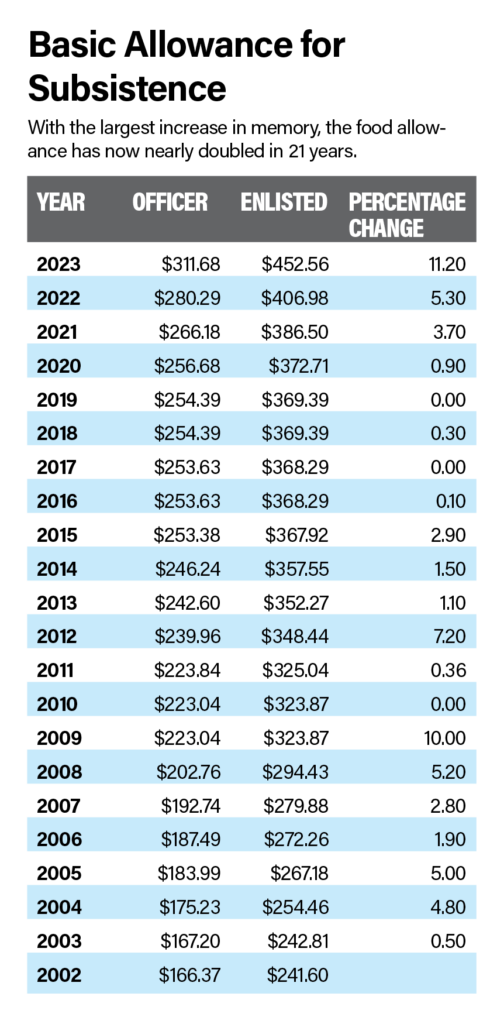DOD Scores a Record $858B Defense Budget
By Greg Hadley
Congress closed out 2022 with a bang, passing a $1.7 trillion omnibus spending package that included a record $858 billion for defense—up 10 percent from 2022.
After nearly three months operating under continuing resolutions that extended 2022 spending levels, the funding measure finally opened the way to new spending, just in time for the start of the fiscal year’s second quarter. Days earlier, lawmakers passed the annual National Defense Authorization Act, the law that authorizes programs and policies affecting national defense.
“It’s gratifying to see strong bipartisan support for the Department of Defense,” said AFA Chairman of the Board Bernie Skoch. “AFA is particularly pleased that with this legislation Congress is increasing our nation’s investment in national defense, and in particular in our Air and Space Forces. We encourage President Biden to sign this bill into law and to continue improving, modernizing, and strengthening our armed forces in the year to come. Never has having a ready and capable military been more critical to our nation.”
Never has having a ready and capable military been more critical to our nation.Air & Space Forces Association Chairman of the Board Bernie Skoch
AFA also praised the Chairmen and Ranking Members of the two Armed Services Committees, Sen. Jack Reed (D-R.I.), Chairman of the Senate Armed Services Committee and Sen. Jim Inhofe (R-Okla.), the Ranking Member; and Rep. Adam Smith (D-Wash.), Chairman of the House Armed Services Committee, and Rep. Mike Rogers, (R-Ala.), Ranking Member. The 2023 NDAA was named for Inhofe, who retired at the end of this term.
Between them, the authorization and appropriations measures funded major increases in pay and allowances, including:
- A 4.6 percent pay raise, the biggest in 20 years. Congress asked DOD to direct an external study to review “the value of basic pay for members of the Armed Forces,” and reassess the underlying model used to determine basic pay. DOD must report back to Congress on its progress in April, December, and again in 2024, lawmakers said.
- A record increase in the Basic Allowance for Housing to keep up with inflation by tacking on an extra 2 percent to rates. Separately, lawmakers asked the Pentagon to report back on the “efficiency and accuracy of the current system used to calculate BAH,” which is based on surveys of about 400 rental markets nationwide and offer potential alternatives.
- Increases in the Basic Allowance for Subsistence, the military food allowance, by 11.2 percent. The new enlisted rate is $452.56 per month, while the rate for officers reaches $311.68. That’s the biggest year-over-year increase since 2002.
- Expands eligibility for the new Basic Needs Allowance, which can supplement the pay of junior service members with large families to keep them from relying on other public benefits. The measure opens eligibility to any service member whose gross family income is up to 150 percent of the federal poverty guidelines, based on family size.
- The measures also fund additional aircraft purchases over and above those sought in the 2023 President’s Budget Request, cleared the way for some of the aircraft divestments the Air Force had sought, and blocked some other such moves. For example, the measures fund:
- Up to 44 new F-35A Lightning II jet fighters, an increase of 11 over what the 2023 request. The NDAA did not specify a number of F-35As, instead authorizing a dollar limit of $4.09 billion; appropriators added another $150 million to that total. The Air & Space Forces Association campaigned hard for such an increase throughout 2022.
- An extra $2 billion over the 2023 request for classified programs, which include advanced weapons and platforms, including the Next-Generation Air Dominance family of systems.
- An additional $600 million over the request for the service’s HH-60W Combat Rescue Helicopter program. USAF had planned to cut its planned fleet from 113 aircraft to 75, but Congress objected.
After years of clashes over Air Force attempts to retire older aircraft—a strategy dubbed “divest to invest” in order to fund the development of new weapons platforms—Congress relented in the 2023 NDAA on several fronts.
In response to the Air Force request to retire 21 A-10s, Congress reduced its mandate to retain 171 A-10s by 18, dropping the required number to 153. And to enable the Air Force to retire 13 aging KC-135s, the NDAA reduces the minimum number of aerial tanker aircraft from 479 to 466 planes. And Congress agreed to eliminate a 2019 mandate to maintain at least six E-8C Joint Surveillance Target Attack Radar System (JSTARS) aircraft, enabling the service proceed with its plan to retire eight of 16 remaining E-8s in 2023 and four more in 2024.
But when it came to retiring the Air Force’s early-model Block 20 F-22 Raptor fighters, Congress refused to go along. Those F-22s are used for training today, and are not equipped to operate in combat as the more advanced versions are. Congress considered plans to upgrade the Raptors to the combat configuration, but opted not to when the projected cost went over $1 billion. Instead, it ordered the Air Force to maintain its 184 Raptors and develop a “strategy and execution plan … for conducting formal training for F–22 aircrews,” including the reestablishment of one or more F-22 Formal Training Units. The bill also directed the Air Force comptroller general to report back on precise costs and a potential timeline for upgrading the aircraft.
The NDAA also blocked divestment of F-15 fighters until the Air Force reports back on details of that plan, including detailing where it will locate new-build F-15EXs.
The NDAA would also block any retirement of E-3 AWACS aircraft, contrary to the Air Force’s wish to retire 15 of the 31 airplanes in the fleet. However, the bill includes exceptions that would let the service retire some, depending on its progress in acquiring the E-7 Wedgetail, the planned replacement for AWACS.
Once the Air Force submits an acquisition strategy for the Wedgetail approved by its acquisition czar, it can cut its number of E-3s down to 21. If the service awards a contract for the procurement of E-7s, it can cut the AWACS fleet down to 18.
Congress rejected plans to retire a dozen Air National Guard C-130H and requires the Air Force to maintain a C-130 fleet of at least 271 aircraft. Congress also rejected the plan to retire the C-40 Clipper, used to transport senior military commanders, Cabinet officials, and members of Congress.
“AFA will continue to advocate for the strongest Air and Space Forces possible,” Skoch said. “We are pleased that Congress is taking steps to properly equip our Airmen and Guardians so they can do their jobs to the best of their abilities and return home safely to their families.”
AFA’s efforts to increase budget transparency by eliminating the practice of funneling some $33 billion in intelligence funding through the Department of the Air Force budget were less successful in Congress. Appropriators barred any modification to how the Pentagon structures or presents funds for the National Intelligence Program—which accounts for the so-called “pass-through” spending. But the budget package did not shut down the initiative entirely, specifying that the Secretary of Defense and the Director of National Intelligence can “study and develop detailed proposals for alternative financial management processes.”
While such a study would need to account for counterintelligence risks and be certified by affected intelligence agencies, lawmakers appeared open to a plan that would “help achieve auditability, improve fiscal reporting, and will not adversely affect counterintelligence” according to the budget law.
What the 2023 Budget Funds for USSF

By Greg Hadley
Congress added more than $1.7 billion to the Pentagon’s Space Force budget request for fiscal 2023, including nearly $770 million extra for research, development, testing, and evaluation, and more than $447 million for procurement, on top of a record $4.08 billion request. Operations and maintenance accounts got a plus-up of $150 million.
Lawmakers pressed the Space Force on its already high priority of making U.S. military satellites more resilient in the face of growing threats in space. The NDAA requires the Secretary of Defense, in consultation with the Director of National Intelligence, to make publicly available the department’s strategy for protecting and defending satellites in orbit. It also demands the Space Force must develop “requirements for the defense and resilience of the satellites” before any major satellite acquisition program achieves Milestone A approval—the earliest milestone in the process.
In a related requirement, lawmakers directed the Space Fore to expand plans to develop “tactically responsive space capability”—the ability to quickly launch new satellites as needed. Congress has pressed for such a program for several years, emphasizing the need this year not only not to be able to launch satellites quickly, but also sustain and control satellites once in space.
Congress wants the Secretary of the Air Force to provide long-term continuity plans for such tactically responsive capabilities through the Future Years Defense Program, which looks five years into the future, and to oversee development of “tactics, training, and procedures” for tactically responsive operations. It requires an annual plan delivered to Congress through 2026.
Lawmakers also asked the Secretary of Defense to look into “whether the Space Development Agency should be exempt from the Joint Integration and Development System in order to speed overall fielding of proliferated space systems.” The SDA’s aggressive, commercial-style approach to developing a proliferated constellation of satellites in low-Earth orbit, dubbed the National Defense Space Architecture, has gained attention for its apparent progress, but some question whether it should have to follow the same joint oversight required of most other Defense Department acquisition programs.
Structure
As in years past, the NDAA includes several provisions giving the Chief of Space Operations the latitude to vary end strength, both for the entire service and for specific ranks, as needed. With the Space Force still accepting interservice transfers and recruiting highly trained personnel from industry, the exact numbers and ratios of Guardians are still stabilizing.
Efforts to establish a Space National Guard did not succeed; the Biden administration has opposed that concept, endorsing instead a hybrid “Space Component” with both Active-duty and Reserve components integrated as one, enabling the service to employ both full-time and part-time Guardians. While the NDAA did not endorse that concept, it did task the Secretary of Defense to report to Congress with details on how such an integrated organization might work, including how promotions, changes in duty status, and retirement might work. Likewise, Congress wants insight into what laws might need to be changed to support this approach, and a review of impacts on budget, diversity, and risks over conflicts of interest for part-time Guardians working for Space Force contractors.
Lawmakers also expressed concern about the new National Space Intelligence Center, currently run by Space Delta 18, because it is subordinate to the service’s Space Operations Command, “rather than a field operating agency aligned to the Director of Intelligence, Surveillance, and Reconnaissance of the Space Force.” The question is whether there are any “perceived mission misalignment, potential mitigating measures, or other structural organization concerns” related to this structure.
Finally, the NDAA questioned “the manning required to fully staff the current and planned cyber squadrons of the Space Force.” The Space Force currently has a number of cyber-focused squadrons, some within Space Delta 6 focused on defensive cyber operations for space systems and others nested within the Space Force element in the National Reconnaissance Office.

